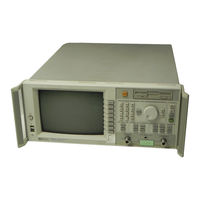User Manuals: HP HP 8712ET RF Network Analyzer
Manuals and User Guides for HP HP 8712ET RF Network Analyzer. We have 6 HP HP 8712ET RF Network Analyzer manuals available for free PDF download: User Manual, User Manual Supplement, Installation Note, Quick Start Manual
HP HP 8712ET User Manual (480 pages)
RF Network Analyzers
Brand: HP
|
Category: Measuring Instruments
|
Size: 3.96 MB
Table of Contents
Advertisement
HP HP 8712ET User Manual Supplement (116 pages)
Automating Measurements, RF Network Analyzers
Brand: HP
|
Category: Measuring Instruments
|
Size: 0.55 MB
Table of Contents
HP HP 8712ET Installation Note (7 pages)
Installation Instructions for the CPU Board HP 08714-60175 new and HP 08714-69175 rebuilt-exchange
Brand: HP
|
Category: Measuring Instruments
|
Size: 0.06 MB
Table of Contents
Advertisement
HP HP 8712ET Quick Start Manual (4 pages)
Brand: HP
|
Category: Measuring Instruments
|
Size: 0.18 MB
HP HP 8712ET Quick Start Manual (4 pages)
Cellular Antenna
HP HP 8712ET Quick Start Manual (4 pages)
CATV
Brand: HP
|
Category: Measuring Instruments
|
Size: 0.14 MB





